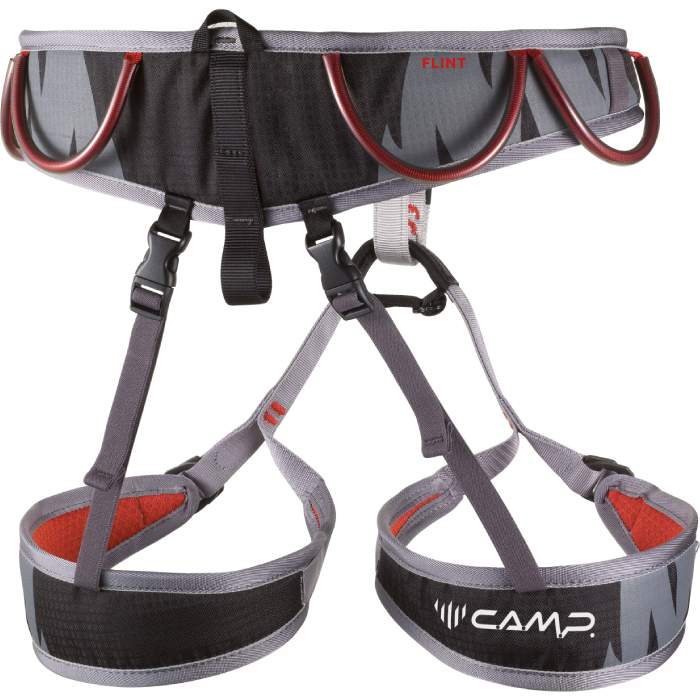Safety and Technical Information for CAMP Harnesses
Flint
Description
ROCK CLIMBING, MOUNTAINEERING
• Updated for 2014 with new graphics to coordinate with the popular Armour helmet
• Auto-locking buckles on the waist and legs
• Comfortable 6 mm EVA foam padding
• Patented No-Twist belay loop
• Drop seat with plastic buckles
• 4 webbing reinforced gear loops and haul loop
• Available in 3 sizes and 2 colors
The Flint has been a popular and welcome addition to price-point harnesses where it blows the competition away with a patented belay loop, robust materials and construction, and technical features that make it ready for any adventure. Use it for top roping in the gym one day and gunning trad routes in the mountains the next. With four webbing reinforced gear loops, adjustable leg loops, drop seat buckles, patented No-Twist belay loop and a haul loop, the Flint is ready for anything you plan to throw its way.
ROCK CLIMBING, MOUNTAINEERING
• Updated for 2014 with new graphics to coordinate with the popular Armour helmet
• Auto-locking buckles on the waist and legs
• Comfortable 6 mm EVA foam padding
• Patented No-Twist belay loop
• Drop seat with plastic buckles
• 4 webbing reinforced gear loops and haul loop
• Available in 3 sizes and 2 colors
The Flint has been a popular and welcome addition to price-point harnesses where it blows the competition away with a...
read moreRetail price
When you click a link below and then checkout online, no matter what you buy (climbing gear or not), we get a small commission that helps us keep this site up-to-date. Thanks!
Weight (g)  | 460 g M : 460 g / 16.2 oz |
| Fit | Unisex |
| Sizes | XS, S, M, L, XL |
Gear Loops  | 4 Gear loops |
Ice Clip Slots  | No, 0 |
| Belay / Tie-In | One Loop |
| Waist Buckle Type | Quick Adjust |
| Leg Buckle Type | Quick Adjust |
| Drop Seat | Yes |
Haul Loop  | Yes (14kN) |
| Certification | |
| Size Chart | S (will fit the upper range of XS) |
No reviews yet.
If you know of a good product video that should be here, let us know, and we'll put it up.
If you're looking for gear videos in general, check out our Vimeo and YouTube channels to see the newest gear.
A pictoral representation of UIAA-105 and EN-12277 standards for harnesses.
The UIAA equipment standard provides a baseline for equipment performance in a test lab under controlled conditions on new equipment. Although these test conditions are relevant to the conditions encountered climbing, conditions encountered at the crags and the condition of the equipment are equally important. This recommendation from the UIAA member federation The British Mountaineering Council (BMC) provides vital equipment information that is NOT explicitly addressed in the standard, particularly failure modes of the equipment and recommendations for the use, inspection, maintenance, and retirement of equipment.















